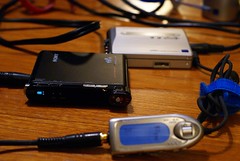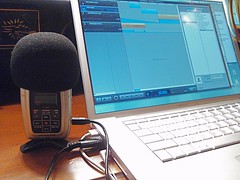 I’ve finally broken down and abandoned my beloved minidisc for mobile audio recording. I held out for as long as I could, which wasn’t hard. Until recently the format that never caught on (in the US) was the best portable digital audio recording format, especially when Sony finally unveiled Hi-MD four years ago finally allowing us to upload our recordings directly to our computers, not just download from them.
I’ve finally broken down and abandoned my beloved minidisc for mobile audio recording. I held out for as long as I could, which wasn’t hard. Until recently the format that never caught on (in the US) was the best portable digital audio recording format, especially when Sony finally unveiled Hi-MD four years ago finally allowing us to upload our recordings directly to our computers, not just download from them.
Then, about three years ago, recorders using memory cards came on the scene offering more convenience and equivalent sound quality, although for more money. Already invested in minidisc gear going back to 1997 I was tempted, but the continued good service of my MD recorders kept me from straying.
But things change. Come 2008 my most recent (circa 2006), and most expensive minidisc recorder has developed issues, and as far as I can tell Sony has no plans to release any new minidisc recorders. However, new ones are still available.
With a trip to NYC planned along with an appointment to do an interview at Neighborhood Public Radio I broke down and bought a Zoom H2 “Handy Recorder.” I’m not going back.
Because of my professional occupation in educational media I’ve had the luxury of messing around with flash memory audio recorders from Marantz, M-Audio and Zoom, so I’ve had a chance to try out features and get to know their benefits and problems.
I was especially intrigued by Zoom’s first recorder, the H4, for it’s comparatively low cost, but inclusion of such pro features as XLR balanced mic jacks. The most interesting things about the H4 is the quality of its built-in stereo microphones. Unlike any under-$1000 recorder that came before, these mics are clearly not afterthoughts and meant to be used.
Then, last year Zoom came out with an even less expensive model, the H2. While you give up some pro features, like the XLR jacks, you gain two additional microphones and the ability to record surround sound. At first I thought this arrangement represented a hollow bit of bling-bling at the expense of quality. But then I read reviews that found the quality to be quite good. I also started talking to other folks who adopted early and sang its praises.
While I like the XLR jacks on the H4, my prior experience left me feeling lukewarm about the actual quality of the mic preamps. Using a basic dynamic mic (like a Shure SM58) the level runs low on the H4, with a fair amount of hiss. Condensers work better, but aren’t always a good fit for field recording. On top of that, the H4 looks like a tazer, which makes me wonder if anyone ever gets harassed at airport security with one in their carry-on.
 So, I ordered the H2 for under $200 and put it to the test with an interview. I am impressed. I can barely believe that four decent quality mics are mated to a good digital audio recorder in a package the size of two iPods can work so well at that price. I do have to admit that the construction feels light and cheap — the plastic isn’t too different from what you’d find on a $19 CD discman at the discount store. By comparison, my minidisc recorders have metal cases that inspire more confidence.
So, I ordered the H2 for under $200 and put it to the test with an interview. I am impressed. I can barely believe that four decent quality mics are mated to a good digital audio recorder in a package the size of two iPods can work so well at that price. I do have to admit that the construction feels light and cheap — the plastic isn’t too different from what you’d find on a $19 CD discman at the discount store. By comparison, my minidisc recorders have metal cases that inspire more confidence.
The killer feature for me is the ability to record the four mics separately into two two-channel stereo pairs. These two stereo pairs are recorded into two separate files that are otherwise completely sync’d. This is great for doing interviews in the field where you want to record both yourself and your subject without having to move the mic around like you’d have to do with a handheld microphone.
For the interview features on last week’s radioshow, I positioned the mic on the table between myself and the interviewee — we sat on opposite sides. What I ended up with is two stereo .wav files, one in which I was closer and louder, and another where the interviewee was more prominent. I sync’d them both up in multitrack software (er… GarageBand) and mixed them together, muting my file when I wasn’t talking.
I had to produce the entire show on the road. So instead of lugging a mixer and mic with me as I’ve done in the past I just used the H2 to record all my voiceovers, too. The overall quality isn’t as nice as my large-diaphragm condenser mic through a mixer, but it’s so damn close.
All the better, now that SD memory cards with 2 – 4 GB run $15 – $20 the price-per-minute for storage is even competitive with Hi-MD, where 1 GB blanks cost about $5. With a 4 GB card I have 6 hours of full uncompressed CD-quality recording available to me — great for conferences or other events. If I’m willing to live with MP3 compression, that 4 gig card will deliver 20 – 60 hours of record time.
The age of direct-memory recording is here and truly feasible for audio. Video is just starting to become reasonable, depending on how patient you’re willing to be. A little part of me will always love minidisc, just not the part that likes dragging and dropping 60 minute audio files in less than a minute.
Leave a Reply